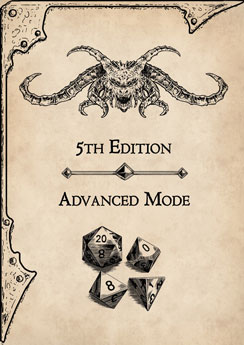Large monstrosity (sphinx), neutral
Armor Class 17 (natural armor)
Hit Points 136 (13d10 + 65)
Speed 40 ft., fly 60 ft. (limited flight)
Proficiency Bonus +3
Proficiency Bonus +6 (5th Edition Advanced Mode)
| STR | DEX | CON | INT | WIS | CHA |
|---|---|---|---|---|---|
| 23 (+6) | 10 (+0) | 20 (+5) | 7 (-2) | 12 (+1) | 10 (+0) |
Saving Throws Str +9, Con +8
Skills Perception +8, Stealth +3
Resistances fire
Senses passive Perception 19
Languages Draconic, Sphinx, Common
Challenge 7 (2,900 XP)
Pounce. If the dragonne moves at least 20 feet straight toward a creature and then hits it with a claw attack on the same turn, that target must succeed on a DC 17 Strength saving throw or be knocked prone. If the target is prone, the dragonne can make one bite attack against it as a bonus action.
ACTIONS
- Multiattack. The dragonne makes three attacks: one with its bite and two with its claws.
- Bite. Melee Weapon Attack: +9 to hit, reach 5 ft., one target. Hit: 19 (2d10 + 8) piercing damage.
- Claw. Melee Weapon Attack: +9 to hit, reach 5 ft., one target. Hit: 15 (2d6 + 8) slashing damage.
- Roar (Recharge 4-6). The dragonne emits a powerful roar. Each creature within 120 feet of the dragonne that can hear it must succeed on a DC 16 Constitution saving throw or have their Strength score reduced by 50% for 1 minute. Creatures that succeed on the saving throw are unaffected. Additionally, any creature within 30 feet of the dragonne when it roars is deafened for 1 minute rounds. The deafened condition means a creature can’t hear and automatically fails any ability check that requires hearing.
5th Edition Advanced Mode
Limiting the power of a character and making the overall difficulty of the game harder, does not reduce the creativity, indeed it does quite the opposite.
The Game Master has the option to use any and all of the instances proposed in this guide, or just some of them according to their preference.
It is the lack of something that move and motivate characters, not the abundance of it
DESCRIPTION
The Dragonne is a majestic and formidable creature, a blend of the regal brass dragon and the mighty lion. With its brassy scales and leonine mane, it presents an awe-inspiring sight. The Dragonne’s eyes, often a striking brass color, peer out from beneath feathery eyebrows, adding to its noble demeanor. Despite its fearsome appearance, the Dragonne is not inherently evil; it is a creature of neutrality, acting fiercely only when its territory is threatened.
COMBAT
In battle, the Dragonne is a force to be reckoned with. Its territorial nature means it will fiercely defend its home against intruders. The Dragonne’s roar is a weapon in its own right, capable of weakening the resolve and strength of those who hear it. While it may allow trespassers a chance to retreat, those who ignore the warning will face the Dragonne’s wrath.
HABITAT / SOCIETY
Dragonnes are solitary creatures, claiming vast territories as their own. They prefer warm temperate to tropical climates, making their homes in deserts and hills. The Dragonne’s lair is its sanctuary, and it will not tolerate any encroachment. They are found in pairs only during their brief mating season, late in the autumn. Dragonnes lay eggs, like their reptilian ancestors, and only one egg is produced a year by any dragonne.
ECOLOGY
As carnivores, Dragonnes typically hunt large herd animals, such as goats, antelopes, or camels. They are known to prey on humanoids only in dire circumstances, such as famine. Despite their fearsome reputation, Dragonnes do not actively seek out conflict with travelers and will only engage when provoked or when their territory is under direct threat.
The Dragonne is considered a more primitive relative of the sphinx, sharing some linguistic and ecological traits. This connection hints at a shared ancestry, though the Dragonne’s behavior and society are far less complex than those of their enigmatic cousins.
